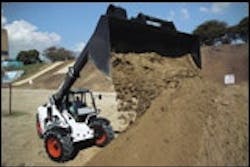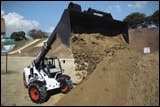Could Telehandlers Be the New Skid-Steer Loader?
- Caterpillar
- Genie
- JLG
- Pettibone
- Mustang
- Manitou
- JCB
- Gradall
- Terex
- MEC
- SkyTrak
- Carelift
- Gehl
- John Deere
- Bobcat
- Xtreme
- Liftking
- Ingersoll Rand
- Lull
- Average Telehandler Costs
- Telehandler Specs: 6,000-Pound Models
A flurry of European and Euro-inspired compact telehandlers introduced to North America seems to be creating two functional classes within the fast-growing telehandler market: lift-and-place machines and tool carriers. Low-boom, compact machines were virtually unheard of here until a few years ago when manufacturers began bringing them to our shores and convincing contractors, agri-business, landscapers, building-supply stores, and others to buy machines with width and height like a skid-steer loader but considerably more reach.
The sales pitch for these low-boom telehandlers focuses on versatility. Most models carry the same quick-attach couplers as their skid-steer and backhoe-loader-line mates.
Not every telehandler is built to compete with skid-steer loaders for bucket work, though. Digging and back-dragging stresses are hard on the chains or cables used in traditional pick-and-place telehandler booms, but tool-carrier booms are designed to handle that work.
A hydraulic cylinder extends the first boom section of telehandlers that are built as forklifts, and chains or cables fixed to that section simultaneously extend the third and fourth boom sections. Boom sections don't come to rest against a firm stop.
"Any time you use the joystick by itself, you're OK -- the boom is designed to withstand the force of the crowd cylinder," explains Mike Popovich, training director at JLG. "So it's OK, although not recommended, to boom in while pushing down on material. But when you have the boom retracted to its limit, don't put the machine in reverse and drag the bucket with the ground drive."
That kind of force will break the boom's chains or cables. If you're tearing up the bucket you bought with your telehandler, you're over-applying the machine and the boom will likely be the next casualty.
Machines manufacturers often refer to as "tool carriers" are usually low-boom-mount machines, and they are typically limited to two boom sections (although JCB makes three-section tool carrier booms). All boom sections extend under the direct pressure of a hydraulic cylinder, and there are no chains or cables.
The versatility sales pitch notwithstanding, most telehandlers here in North America are still primarily forklifts. Eleven pick-and-place telehandler models are available with sliding boom carriages -- four from Pettibone (two 6,000-pound machines and two 8,000 pounders), three that carry JLG's Lull brand (one 6,000-pound unit, one 9,000-pounder, and one at 10,000 pounds), and Liftking's 12,000-, 15,000-, 20,000- and 30,000-pound models.
Smooth horizontal movement of the entire boom discourages operators from trying to back the forks out from under pallets. Driving the machine with the boom raised is dangerous, particularly on a construction site where any change in grade or underfoot conditions will wave the boom around and could cause the machine to tip.
There are four models available -- two French Manitous and two Italian Xtremes -- with boom-mounts that rotate, slewing like a crane. Manitou fields a 6,300-pound model with 45 foot-7 inch lift height and a 10,000-pound model with nearly 68 feet of lift height. Xtreme's 8,000-pound machine has a maximum height of 43 feet 2 inches and the 10,000-pounder reaches 67 feet 7 inches high. The 10,000-pound machines are the highest-reaching telehandlers in the market.
"Previously, the best year for telehandlers in North America saw about 14,000 machines shipped," says David Baxter, JLG director of marketing. "Although final numbers are not yet available, the total number of machines shipped for 2005 will be on the order of 20,000. That's a significant increase and we attribute it to the realization by new end-users of the versatility and productivity a telehandler provides."
Manufacturers that are serious about North American market share can't afford to ignore that kind of sales growth. In a very practical sense, those that want to be taken seriously by equipment dealers need a telehandler line. And it's typically most economical for the dealer to get the telehandler from the same manufacturer from which they buy skid-steers and backhoe-loaders, or boom and scissor lifts.
Lifting-equipment manufacturers and dealers can trade on their expertise, using the telehandler's aerial-equipment nature as a way to reach customers who may not buy work platforms or cranes.
As a result, we see Terex painting its telehandlers blue and marketing them through Genie dealers. Work-platform specialist, MEC, has launched its own telehandler line, and Haulotte is building a new plant in Spain to make, among other things, its own telehandlers.
Case and New Holland expect to re-enter the North American telehandler market with new product by the end of this year. Thomas purchased Tovel to add a telehandler to its compact-equipment line, and Gehl is investing $6.5 million to expand its Yankton, S.D., facility and increase telehandler production by 50 percent.
In an uncharacteristic outsourcing, Caterpillar signed a supply agreement with JLG for its telehandlers. Clearly telehandlers are an important part of the Cat product line, but it appears they're unique enough that the Peoria giant, traditionally a do-it-yourselfer, wants JLG to supply the Cat-spec'd machines.
Perhaps even more unusual is the decision by the owner of the country's largest privately held equipment-rental company, Don Ahern, to enter the telehandler business. Ahern founded Xtreme manufacturing, despite the number of brands already in the marketplace, because of the perceived lack of competition for sales of a rugged, highly durable machine.
"In our opinion, the single most dynamic market factor affecting the telescopic-handler industry is manufacturing consolidation that has reduced competition," says Elesha Rasmuson, vice president of administration and sales for Xtreme. "It has reduced technological development."
Nevertheless, marketers are speaking of telehandlers with the kind of fervor for versatility reserved for backhoe-loaders or skid-steer loaders. And given double-digit growth in sales of telehandlers, tool-carrier models may just turn out to be the skid-steer-loader alternative that some claim them to be. If you're in the market for a machine to do some bucket work with, though, pay close attention to boom construction. Make sure you're getting a machine that will withstand the versatility promise.


